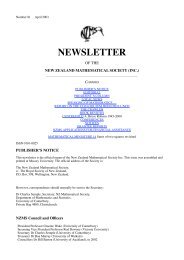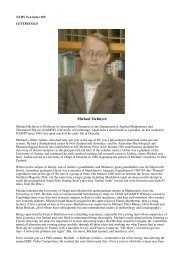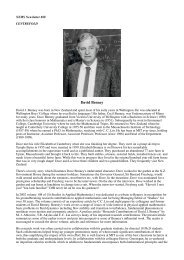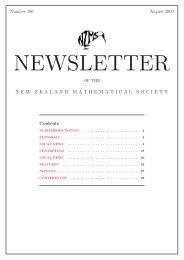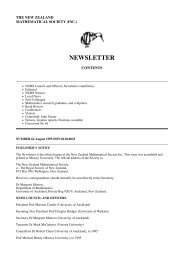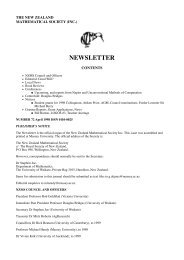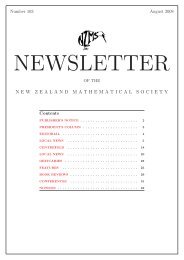newsletter - New Zealand Mathematical Society
newsletter - New Zealand Mathematical Society
newsletter - New Zealand Mathematical Society
Create successful ePaper yourself
Turn your PDF publications into a flip-book with our unique Google optimized e-Paper software.
possible, in a friendly manner, has resulted in a text which may be misleading in places.<br />
For instance, the authors discuss in (9.4) the Sturm-Liouville problem. The main result from this<br />
important area is, probably, the completeness of the system of eigenfunctions (Th.9.42). Here the easy<br />
style of the authors brings the unwary reader to the edge of a dangerous swamp by failing to give<br />
sufficient emphasis to the necessity for the function r to be strictly positive on the interval.<br />
The last, but not the least of my remarks is about the list of references, You may find numerous classical<br />
books in it (like Courant and Hilbert's "Methods of <strong>Mathematical</strong> Physics" or Titchmarsh's<br />
"Eigenfunction expansions") but few of recent vintage. Presumably the recent books by Bartle and Lieb<br />
in the AMS Graduate Studies in Mathematics series and a handful of publications by Kurzweil and others<br />
on the Kurzweil-Henstock integral are too recent to have been included.<br />
All the previous remarks were about the choice of the material and the style. One can also find some<br />
shaky places in the proofs provided. Generally the statements (when proven) are proven accurately. But<br />
the approaches are not systemized, the choice of them is done at random. Sometimes the proofs are too<br />
discursive or too formal. For instance theorem 27.4 gives a condition for boundedness of variation in<br />
terms of absolute continuity. The proof is long and formal. In fact, by defining the absolute continuity as a<br />
uniform estimate , the authors<br />
could use the triangle inequality to estimate the variation V a of the function on the lattice<br />
uniform lattice,<br />
by variation of the function on the product of lattices with the<br />
Still, I guess that creation of a friendly, honest and attractive textbook (or rather a book of problems with<br />
accompanying commentary) for modern students learning classical analysis at Stage 3, is POSSIBLE.<br />
The book in question is a step in this direction but it demonstrates that any attempt to bring students to the<br />
front-line of professional mathematics while avoiding the classical theorem of Analysis is a difficult task,<br />
which needs very accurate placed and exact comments from the tutor, and can't be left entirely to a<br />
written text like one referred to. So I would recommend this book for use by a qualified tutor who could<br />
combine the friendly approach with the production of attractive vistas and exact criticism but I would<br />
hesitate to recommend it to students for independent reading.<br />
Boris Pavlov<br />
The University of Auckland<br />
THE PROBLEM OF INTEGRABLE DISCRETIZATION: HAMILTONIAN APPROACH<br />
by Yuri B. Suris, Birkhäuser-Verlag, 2003, 1092 pp, EU 158.36. ISBN 3-7643-6995-7.<br />
In one of the earliest and still one of the most striking and influential uses of computers in mathematics,<br />
Enrico Fermi and Stanislaw Ulam decided in the early 1950s to use the then brand-new {\sc maniac}<br />
computer at Los Alamos to study problems in physics. They sought a problem which was simple to state<br />
but could not be solved by the existing mechanical computers, and settled on the nonlinear discrete string<br />
(or "lattice'') described by the ODEs<br />
= k(y i + 1 - 2 y i + y i - 1 ) + k a((y i + 1 - y i ) 2 - (y i - y i - 1 ) 2 )<br />
with boundary conditions y 0 (t) = y N (t) = 0 and initial conditions y i (0) = sin(ip/N). Taking up the story in<br />
Ulam's own words,<br />
"Our problem turned out to have been felicitously chosen. The results were entirely<br />
different qualitatively from what even Fermi, with his great knowledge of wave motions,<br />
had expected. The original objective had been to see at what rate the energy of the string,<br />
initially put into a single sine wave (the note was struck as one tone), would gradually<br />
develop higher tones with the harmonics, and how the shape would finally become "a<br />
mess'' both in the form of the string and in the way the energy was distributed among<br />
higher and higher modes. Nothing of the sort happened. To our surprise the string started




